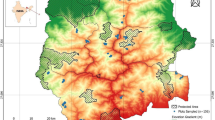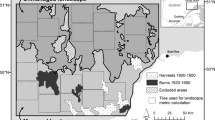Abstract
We examined the composition and structure of forest communities in a 3700 ha watershed in relation to environmental gradients and changes in land management practices. We identified four mixed-conifer forest types dominated by different combinations of Abies concolor, Picea pungens, Pinus ponderosa, Populus tremuloides, and Pseudotsuga menziesii, and a spruce-fir type dominated by Picea engelmannii and Abies lasiocarpa. The forest types occur in a complex pattern related to elevation and topographicmoisture gradients and variations in past fire regimes. However, widespread regeneration of A. concolor following possible changes in the fire regime in the late 19th century and continuing with institution of a fire suppression policy early in the 20th century is producing a more homogenous mixed-conifer forest with greater horizontal and vertical continuity of fuel. This shift toward landscape homogeneity not only may adversely affect biodiversity, but also may be perpetuated as the probability of large, high-severity fires increases with continued fire suppression.
Similar content being viewed by others
References
Ahlstrand G. M. 1980. Fire history of a mixed-conifer forest in Guadalupe Mountains National Park. USDA Forest Service General Technical Report RM-81, Rocky Mountain Forest and Range Experiment Station, Fort Collins, Colorado.
Alexander R. R. 1974. Silviculture of central and southern Rocky Mountains: a summary of the status of our knowledge by timber types. USDA Forest Service Research Paper RM-120, Rocky Mountain Forest and Range Experiment Station, Fort Collins, Colorado.
Alexander R. R., Shearer R. C. & Shepperd W. D. 1984. Silvical characteristics of subalpine fir. USDA Forest Service General Technical Report RM-115, Rocky Mountain Forest and Range Experiment Station, Fort Collins, Colorado.
Alexander R. R. & Shepperd W. D. 1984. Silvical characteristics of Engelmann spruce. USDA Forest Service General Technical Report RM-114, Rocky Mountain Forest and Range Experiment Station, Fort Collins, Colorado.
Brown, D. E. 1982. Biotic communities of the American southwest-United States and Mexico. Special Issue, Desert Plants 4 (1–4).
Cooper C. F. 1960. Changes in vegetation, structure and growth of southwestern pine forests since white settlement. Ecological Monographs 30: 129–164.
Daubenmire R. F. 1943a. Vegetational zonation in the Rocky Mountains. Botanical Review 9: 325–393.
Daubenmire R. F. 1943b. Soil temperature versus drought as a factor determining lower altitudinal limits of trees in the Rocky Mountains. Botanical Gazette 105: 1–13.
Debyle N. V. & Winokur R. P. (eds.). 1985. Aspen: ecology and management in the western United States. USDA Forest Service General Technical Report RM-119, Rocky Mountain Forest and Range Experiment Station, Fort Collins, Colorado.
De Velice R. L., Ludwig J. A., Moir W. H. & Ronco F. R.Jr. 1986. A classification of forest habitat types of northern New Mexico and southern Colorado. USDA Forest Service General Technical Report RM-131, Rocky Mountain Forest and Range Experiment Station, Fort Collins, Colorado.
Dietrich J. H. 1983. Fire history of a southwestern mixedconifer: a case study. Forest Ecology and Management 6: 13–31.
Dye A. J. & Moir W. 1977. Spruce-fir forest at its southern distribution in the Rocky Mountains, New Mexico. American Midland Naturalist 97: 133–146.
Fechner G. H. 1985. Silvical characteristics of blue spruce. Forest Service General Technical Report RM-117, Rocky Mountain Forest and Range Experiment Station, Fort Collins, Colorado.
Fowells, H. E. 1965. Silvics of forest trees of the United States. Agriculture Handbook No. 271, USDA Forest Service.
Harrington M. G. & Sackett S. S. 1992. Past and present fire influences on southwestern ponderosa pine old growth. In: Kaufmann, M. R., Moir, W. H. & Bassett, R. L. (technical coordinators), Old-growth forests in the southwest and Rocky Mountain regions, proceedings of a workshop, pp. 44–50. USDA Forest Service General Technical Report RM-213, Rocky Mountain Forest and Range Experiment Station, Fort Collins, Colorado.
Hill M. O. 1979. DECORANA-a FORTRAN program for detrended correspondence analysis and reciprocal averaging. Department of Ecology and Systematics, Cornell University, Ithaca, New York.
Kaufmann M. R., Moir W. H. & Covington W. W. 1992. Old-growth forests: what do we know about their ecology and management in the Southwest and Rocky Mountain regions? In: Kaufmann, M. R., Moir, W. H. & Bassett, R. L. (technical coordinators), Old-growth forests in the Southwest and Rocky Mountain regions, proceedings of a workshop, pp. 1–11. USDA Forest Service General Technical Report RM-213. Rocky Mountain Forest and Range Experiment Station, Fort collins, Colorado.
Kearney T. H. & Peebles R. H. 1951. Arizona flora. University of California Press, Berkeley.
Krammes J. S. (technical coordinator) 1990. Effects of fire management of southwestern natural resources. USDA Forest Service General Technical Report RM-191, Rocky Mountain Forest and Range Experiment Station, Fort Collins, Colorado.
Layser E. F. & Schubert G. H. 1979. Preliminary classification of the coniferous forest and woodland series of Arizona and New Mexico. USDA Forest Service Research Paper RM-208, Rocky Mountain Forest and Range Experiment Station, Fort Collins, Colorado.
Madany M. H. & West N. E. 1983. Livestock grazing-fire regime interactions within montane forest of Zion National Park, Utah. Ecology 64: 661–667.
Mann, W. G. & Locke, S. B. 1931. The Kaibab deer: a brief history and recent developments. USDA Forest Service, 70 p.
Merkle J. 1954. An analysis of the spruce-fir community of the Kaibab Plateau, Arizona. Ecology 35: 316–322.
Merkle J. 1962. Plant communities of the Grand Canyon area, Arizona. Ecology 43: 698–711.
Moir W. H. & Ludwig J. A. 1979. A classification of sprucefir and mixed conifer habitat types of Arizona and New Mexico. USDA Forest Service Research Paper RM-207, Rocky Mountain Forest and Range Experiment Station, Fort Collins, Colorado.
Pearson G. A. 1920. Factors controlling the distribution of forest types, part II. Ecology 1: 289–308.
Peet R. K., Knox R. G., Case J. S. & Allen R. B. 1988. Putting things in order: the advantages of detrended correspondence analysis. American Naturalist 131: 924–934.
Rasmussen D. I. 1941. Biotic communities of Kaibab Plateau, Arizona. Ecological Monographs 11: 230–273.
Rehfeldt G. E. 1974. Genetic variation of douglas fir in the northern Rocky Mountains. USDA Forest Service Research Note INT-184. Intermountain Forest and Range Experiment Station, Ogden, Utah.
Smith W. K. 1985. Western montane forests. In: Chabot B. F. & Mooney H. A. (eds.), Physiological ecology of North American plant communities, pp. 95–126. Chapman and Hall, New York.
Swetnam T. W. 1990. Fire history and climate in the southwestern United States. In: Krammes, J. S. (technical coordinator), Effects of fire management of southwestern natural resources, pp. 6–17. USDA Forest Service General Technical Report RM-191, Rocky Mountain Forest and Range Experiment Station, Fort Collins, Colorado.
Vankat J. L. 1982. A gradient perspective on the vegetation of Sequoia National Park, California. Madroño 29: 200–214.
Vankat J. L. 1990. A classification of the forest types of North America. Vegetatio 88: 53–66.
Warren P. L., Reichhardt K. L., Mouat D. A., Brown B. T. & Johnson R. R. 1982. Vegetation of Grand Canyon National Park. Technical Report No. 9. Cooperative National Park Resources Studies Unit, University of Arizona, Tucson.
Weaver H. 1951. Fire as an ecological factor in southwestern ponderosa pine forests. Journal of Forestry 49: 93–98.
Wellner C. F. 1970. Fire history in the northern Rocky Mountains. In: The role of fire in the intermountain west, pp. 42–64. Intermountain Fire Research Council, Missoula, Montana.
White, M. A. 1989. Coniferous forest communities of Thompson Canyon watershed, North Rim region, Grand Canyon National Park, Arizona. M. S. thesis, Miami University, Oxford, Ohio.
White, M. A. & Vankat, J. L. Fire history of the mixed-conifer and spruce-fir forests of the North Rim region of Grand Canyon Park, Arizona, U.S.A. In preparation.
Whittaker R. H. 1973. Ordination and classification of communities. Handbook of Vegetation Science 5. Junk, The Hague.
Wright H. A. 1990. Role of fire in the management of southwestern ecosystems, pp. 1–5. In: Krammes, J. S. (technical coordinator), Effects of fire management of southwestern natural resources, pp. 6–17. USDA Forest Service General Technical Report RM-191, Rocky Mountain Forest and Range Experiment Station, Fort Collins, Colorado.
Wright H. A. & Bailey A. W. 1982. Fire ecology. Wiley, New York.
Author information
Authors and Affiliations
Rights and permissions
About this article
Cite this article
White, M.A., Vankat, J.L. Middle and high elevation coniferous forest communities of the North Rim region of Grand Canyon National Park, Arizona, USA. Vegetatio 109, 161–174 (1993). https://doi.org/10.1007/BF00044748
Accepted:
Issue Date:
DOI: https://doi.org/10.1007/BF00044748




